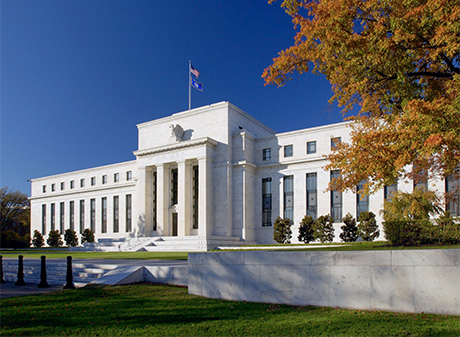A Look at the Fed’s Emergency Lending Programs

The Federal Reserve used its emergency lending powers earlier this year to launch several facilities similar to those created during the 2007-08 financial crisis. Some of these were created jointly with the U.S. Treasury. Such emergency steps were intended to ensure that credit would continue to flow despite the coronavirus pandemic. What’s next for these emergency loan programs, now that the Treasury is withdrawing its support from some programs?
Fed as Lender of Last Resort
Although many people consider the Federal Reserve’s primary mission to be conducting monetary policy, its original purpose was to be a lender of last resort during times of financial panic —that is, to provide emergency loans to financial institutions, to keep the real economy insulated from the worst of such shock.
The Fed’s normal lending operations through the discount window have long been subject to various legal restrictions on to whom it may lend and under what circumstances. But prior to 2010 the Fed had much broader emergency lending powers under Section 13(3) of the Federal Reserve Act. Facilities created or activities pursued under this authority are often called 13(3) (thirteen-three) facilities or actions.
Emergency Lending Facilities during the 2007-08 Financial Crisis
Using 13(3) authority, the Fed created several emergency lending facilities during the 2007-08 financial crisis and took action to prevent disorderly failures of several firms considered “too big to fail” on an emergency basis: AIG, Bear Stearns, Citigroup and Bank of America. Although taxpayers ultimately profited from such actions, wide criticism of these programs prompted Congress to change the law. The 2010 Dodd-Frank Wall Street Reform and Consumer Protection Act (Dodd-Frank) curtailed the Fed’s Section 13(3) lending authority, requiring that emergency lending serve a broad sector, effectively preventing assistance to specific firms. This act also mandated that the U.S. Treasury Secretary approve any 13(3) assistance in advance.
Special Purpose Vehicles to Address the Coronavirus Crisis
In response to the COVID-19 crisis in the spring of 2020, the Fed created or expanded multiple emergency lending facilities, shown in the table below, with special purpose vehicles (SPVs) generally doing the actual lending or holding assets. These facilities were intended to provide credit to a variety of sectors—including small- and medium-sized businesses, money market mutual funds, consumer lending, and corporate and municipal borrowing. As required under the Dodd-Frank Act, Treasury Secretary Steven Mnuchin approved the establishment of these 13(3) facilities.
In conjunction with the creation of these facilities, Congress passed the Coronavirus Aid, Relief, and Economic Security (CARES) Act that allocated up to $454 billion in Treasury funds to augment the Fed’s lending resources and absorb potential losses from defaults on emergency loans. Concerns about the Fed’s legal authority to engage in risky lending may have prompted this infusion of Treasury capital.
Emergency Lending Programs to Expire or Be Extended
On Nov. 19, Treasury Secretary Mnuchin announced that he would not extend five emergency lending facilities past their Dec. 31 sunset clause:
- Main Street Lending Program (MSLP)
- Term Asset-Backed Securities Loan Facility (TALF)
- Primary and Secondary Market Corporate Credit Facilities (PMCCF and SMCCF)
- Municipal Liquidity Facility (MLF)
Secretary Mnuchin and others argued that the programs were an emergency measure for a crisis that has passed and that the programs could be revived in the event of a new financial shock. Further, Secretary Mnuchin said Congress intended that Treasury support for these programs should end on Dec. 31, although other parties dispute this interpretation. At the same time, he asked the Fed to return tens of billions of dollars that Congress had authorized but did not use.
However, Secretary Mnuchin extended the following facilities until March 31, 2021:
- Primary Dealer Credit Facility (PDCF)
- Commercial Paper Funding Facility (CPFF)
- Money Market Mutual Fund Liquidity Facility (MMLF)
- Paycheck Protection Program Liquidity Facility (PPPLF)
The Fed responded to the Secretary’s decision in an emailed statement:
“The Federal Reserve would prefer that the full suite of emergency facilities established during the coronavirus pandemic continue to serve their important role as a backstop for our still-strained and vulnerable economy.”
Consistent with this view, on Nov. 30, the Fed extended several lending facilities—programs for primary dealers (PDCF), commercial paper (CPFF), money market mutual funds (MMLF), and small- and mid-sized businesses (PPPLF)—through March 31, 2021.
As of this writing, some programs are expiring as of Dec. 31, while others are staying at least through March 31, 2021. The circumstances under which these or similar programs could be revived if needed are contingent on the legal framework governing the Fed. The COVID-19 stimulus bill approved by Congress Monday night reportedly restricts the Fed's ability to restart certain emergency lending programs without explicit Congressional approval.
| Program | Funding Target | Announced Treasury Support Amount | Capacity | Initial Announcement Date | Current Status |
|---|---|---|---|---|---|
| Primary Dealer Credit Facility (PDCF) | Primary dealers | — | — | 3/17/20 | Extended through 3/31/21 |
| Commercial Paper Funding Facility (CPFF) | Issuers of three-month unsecured and asset-backed U.S. commercial paper | $10 billion | — | 3/17/20 | Extended through 3/31/21 |
| Money Market Mutual Fund Liquidity Facility (MMLF) | Institutions that buy assets from money market mutual funds | $10 billion | — | 3/18/20 | Extended through 3/31/21 |
| Main Street Lending Program (MSLP) | Small- and mid-sized businesses | $75 billion | Up to $600 billion | 3/23/20 | Ending on 12/31/20 |
| Term Asset-Backed Securities Loan Facility (TALF) | Issuers of securities backed by consumer and small-business loans | $10 billion | Up to $100 billion | 3/23/20 | Ending on 12/31/20 |
| Primary and Secondary Market Corporate Credit Facilities (PMCCF, SMCCF) | PMCCF: issuers of new corporate bond and syndicated loan issuances SMCCF: outstanding corporate bonds, bond ETFs, and market index corporate bond portfolios |
$75 billion | Up to $750 billion | 3/23/20 | Ending on 12/31/20 |
| Paycheck Protection Program Liquidity Facility | Paycheck Protection Program lenders | — | Limited by PPP size | 4/6/20 | Extended through 3/31/21 |
| Municipal Liquidity Facility | U.S. states, localities, and other designated political entities | $35 billion | Up to $500 billion | 4/9/20 | Ending on 12/31/2020 |
Additional Resources
- On the Economy: Financing the U.S. Response to COVID-19
- On the Economy: Corporate Bond Spreads and the Pandemic
- Regional Economist: President’s Message: Monetary Policy and Fiscal Policy Responses to the COVID-19 Crisis
Citation
Christopher J. Neely, ldquoA Look at the Fed’s Emergency Lending Programs,rdquo St. Louis Fed On the Economy, Dec. 22, 2020.
This blog offers commentary, analysis and data from our economists and experts. Views expressed are not necessarily those of the St. Louis Fed or Federal Reserve System.
Email Us
All other blog-related questions


